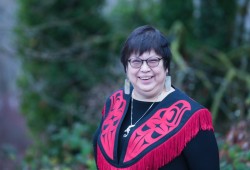In early April, BC Hydro issued a competitive call for power for projects that include, for the first time, 25 per cent First Nation equity. But projects must meet a requirement of 3,000 Gigawatt hours per year, creating a gap for many smaller-scale Indigenous energy initiatives.
“This call for power is 3,000 [GWh/year] you have to have a minimum of 40 megawatt producing power in your project,” said Judith Sayers, Nuu-chah-nulth Tribal Council president. “It's unlikely that any of the Nuu-chah-nulth nations have that large of a project.”
Sayers noted that BC Hydro worked with First Nations in the province to shape this call for power. However, despite attempts to include smaller Indigenous projects, power requirements were already established by the provincial utility, she shared.
But it’s “an amazing opportunity,” said Sayers, noting that this is the first time power projects have required to be at least a quarter owned by First Nations. “Most of the projects that are going to be bidding in are going to be wind projects in the north.”
Yuho Okada is president of the Barkley Project Group, which helps many Nuu-chah-nulth nations with their power projects. He said this call from BC Hydro “took quite some time in making.”
“This is the first call in 15 years,” said Okada.
For years BC Hydro argued that the province had a surplus of energy, said Okada. However, they “adjusted their forecast” due to the need for more supply.
“Now we're actually short of energy in B.C.,” said Okada.
The call for power equates to roughly five large-scale wind projects, Okada said.
“The benefits of this equity requirement [are] only going to be limited to those five, maybe six, seven projects that are going to qualify,” he said. “A lot of the First Nations projects are not going to be eligible because they're sort of small-scale projects.”
“BC Hydro is suggesting there could be a call in 2026 and 2028,” said Sayers. “We just have to keep lobbying and advocating for some of those projects to be smaller projects.”
In June of 2023 the province announced an allotment of $140 million to New Relationship Trust’s (NRT) British Columbia Indigenous Clean Energy Initiative (BCICEI), which supports capacity for First Nations’ clean energy projects. The funding is specifically for small-scale power projects, starting in 2028.
“The general consensus out there is that the $140 million is actually not enough to accommodate all those business interests the First Nations have been developing over these last two decades,” said Okada.
Okada shared that the money from the funding will “run out very, very quickly and then with that, the opportunity will be gone.”
“Like any other developers, First Nations require a certain market indication so that they can continue to invest in their own projects,” he said.
As stated in the BCICEI Discussion paper, the funding “will support a limited number of projects” and the “development team must consider whether to support a few large projects or more smaller projects.”
“There needs to be a consistent replacement program for the standing offer program,” said Kwatuuma, Cole Sayers, executive director of Clean Energy BC. “That’ll be for the smaller projects, that is, smaller than the 40 MW as a minimum for the call for power.”
“First Nations want that,” he added.
Hupacasath’s China Creek project and Tla-o-qui-aht’s canoe creek initiative are some examples of projects that Kwatuuma would like to see included to promote “energy sovereignty.”
“Right now, in Huu-ay-aht and Ditidaht, they can be cut off [from] power in the winter,” said Judith Sayers of the two remote Nuu-chah-nulth communities, “anywhere from seven days to three weeks.”
“If they had their own project right there, their own micro grid, they could put the grid back up and get it running within days, I'm sure,” she said.
According to a past Ha-Shilth-Sa article, in March of 2020 the Ka:'yu:'k't'h'/Che:k'tles7et'h' First Nation’s village of Houpsitas, a located at the mouth of Kyuquot Sound, experienced power outages for over a week.
With cold weather, spoiling food, school closures and “increased potential for physical harm” with residents’ attempts to provide heat for themselves, the nation declared a state of emergency for the village of under 200 residents.
Houpsitas is powered by Kyquot Power Ltd., owned by Synex International, which obtains electricity from BC Hydro for the small community of Kyuquot. The power outages were believed to be caused by a fuse too small for the needs of the community.
Another example of an effective Nuu-chah-nulth project is Canoe Creek Hydro, developed by the Tla-o-qui-aht First Nation and Barkley Project Group, which is supplying energy for the needs of 2,000 homes annually, according to Sayers. But most of Vancouver Island remains powered by hydroelectric sources from Northern B.C. on the mainland.
Vancouver Island receives electricity from Peace River hydroelectric system, Kelly Lake Substation, and from the Columbia River system in Nicola Substation, according to Vancouver Island Economic Alliance - all are located on the mainland.
On Vancouver Island BC Hydro operates four hydroelectric systems and six generating stations, equating to four per cent of the utility’s 46,000 GWh total, according to BC Hydro.
Sayers stressed the significance of ensuring there is enough local power.
“What happens if there's an earthquake?” she questioned. “Or something that stops power between Northern B.C. and Vancouver Island.”
“Then we're without power, and it could be for a long time,” said Sayers, noting that in the event of natural disasters it's important to ensure “that our members have the power that they need, especially our elders.”
Kwatuuma would like to see more “First Nation jurisdiction being asserted” and more control in how to invest in the energy transition.
“First Nations want to be more active players in their territories and infrastructure planning more broadly,” said Kwatuuma.
“Clean energy fits within First Nations worldview as a form of economic development,” he continued. “It's something that has gone global amongst First Nations people.”




